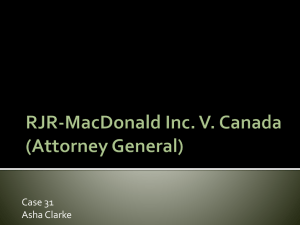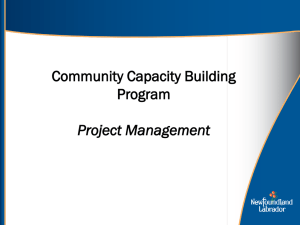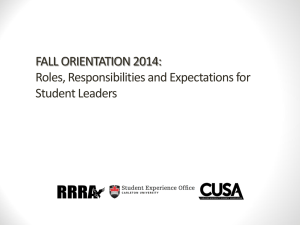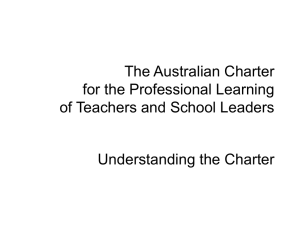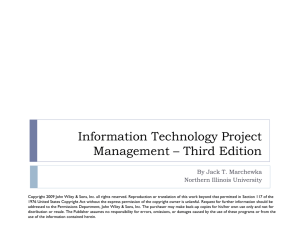to the PowerPoint presentation
advertisement
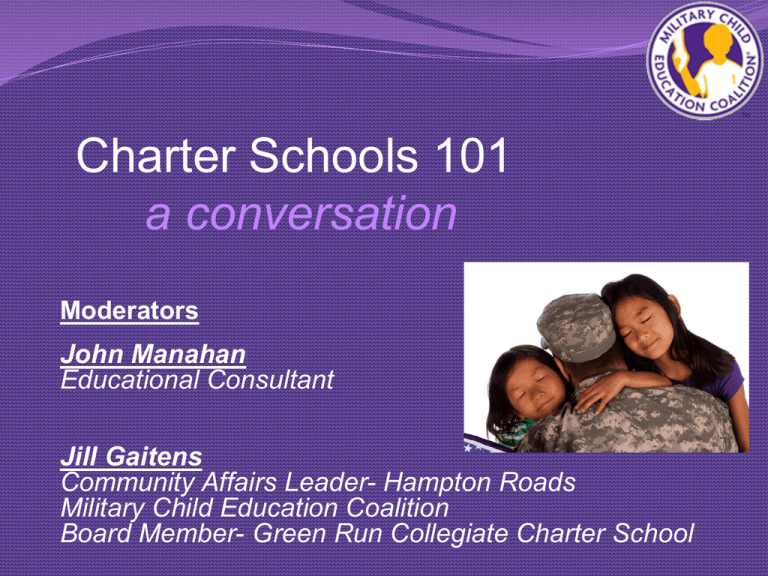
Charter Schools 101 a conversation Moderators John Manahan Educational Consultant Jill Gaitens Community Affairs Leader- Hampton Roads Military Child Education Coalition Board Member- Green Run Collegiate Charter School Goals for this Session Define what a charter schools is and offer some history. Recognize that the military community was an early adopter of school choice and discuss the growth of charter schools on and near installations. Offer guidance regarding development, authorization, and performance accountability. Bruno V. Manno PhD, Senior Advisor for the Systemic K12 Education Reform Focus Area, Walton Family Foundation LaShawndra Thornton, Program Officer, Office of Innovation and Improvement's Charter Schools Program, U.S. Department of Education Don Soifer, Executive Vice President of the Lexington Institute, Board Member, District of Columbia’s Public Charter School Board • All parents want high quality, safe schools for their children. • Schools located near some installations are not perceived as high quality or safe. • Charter Schools on bases are perceived as “community schools”. * • Charter Schools are perceived as more conscious of academic and socioemotional needs of students. Charter Schools on Military Installations Jacksonville Lighthouse Charter School: Flightline Upper Academy, Little Rock Air Force Base (AFB), Arkansas; Sonoran Science Academy Davis Monthan, Davis-Monthan AFB, Arizona; Manzanita Public Charter School, Vandenberg AFB, California; Wheatland Charter Academy, Beale AFB, California; Sigsbee Charter School, Naval Air Station Key West, Florida; LEARN 6 North Chicago, Naval Station Great Lakes, Illinois; Belle Chasse Academy, Naval Air Station/Joint Reserve Station New Orleans, Louisiana; Imagine Andrews Public Charter School, Joint Base AndrewsNaval Air Facility, Maryland. Shared Definition of a Charter School Charter schools are unique public schools that are allowed the freedom to be more innovative while being held accountable for advancing student achievement. Because they are public schools, they are: • Open to all children; • Do not charge tuition; and • Do not have special entrance requirements. National Alliance for Public Charter Schools, 2014 National Alliance for Public Charter Schools (2014) • • • Local/State Funding: • Based on student enrollment • On average charters are funded at 61% of their traditional counterparts1 Federal Funding: • Title funds and Special Education funds (through state) • Charter School Program grants Philanthropy: • Several national and regional foundations have special charter school programs. Source: 1 – the Center for Education Reform - 2012 Who Authorizes Charter Schools? Local school board alone IL, MD, OR, PA, TN, VA, WY State board of education alone Local school board and State board of education First Local school board then State board of education State charter school review board Local school board and State charter school commission Combination (in some cases including higher education and not-for-profit) CT, MA, NJ AR, DE, LA, NH, NM, RI, TX AK, IA, KS D.C., HI GA, ID, SC, UT AZ, CA, CO, FL, IN, MI, MN, MO, NV, NY, NC, OH, OK, WI Source: National Alliance for Public Charter Schools, State Charter Law Rankings Database, 2010*Mississippi's charter law expired at the end of 2009, bringing the total to eleven states without charter school legislation: AL, KY, ME, MS, MT, NE ND, SD, VT, WA, WV National Authorizers 100% Percent of Charter Schools by Authorizer 75% 53% 50% 20% 25% 14% 8% 4% 0% Districts State Agencies Independent Higher Ed. Non-Profits Charter Institutions Boards Source: NASCA: State of Charter School Authorizing: 2010 1% Mayors Bruno V. Manno PhD Senior Advisor for the Systemic K-12 Education Reform Focus Area Walton Family Foundation Charter Schools Public schools that usually have great freedom to be innovative while being held accountable for student and achievement and other results. Foster partnerships between parents, educators, and students. Provide effective education that prepares students for success in college, career, and life. 12 Startup Grants Program Supports creating new charters by providing grants to developers to launch new schools; since 1997 Must serve significant number of low income students in Foundation’s target urban sites Grants for up to $250,000 Reviewed by WFF staff and state and local partners; 3 to 4 month review process 13 Criteria for Judging an Application What is your school design and why have you chosen it? Who is your target student group and community and what are your enrollment projections? How will you select your leaders and teachers and evaluate and support them? What results do you expect for your students? 14 Criteria for Judging an Application How will you manage the school, students, and the enrollment process? Who will be on your board? What are your facility plans? What is your operating budget? 15 LaShawndra Thornton Program Officer Office of Innovation and Improvement Charter Schools Program U.S. Department of Education An Authorizer’s Perspective Don Soifer Executive Vice President of the Lexington Institute Board Member, District of Columbia’s Public Charter School Board



